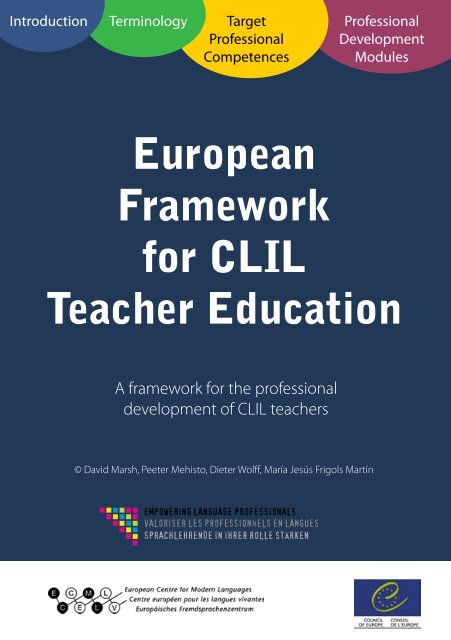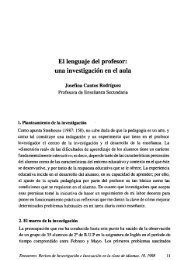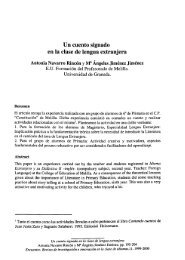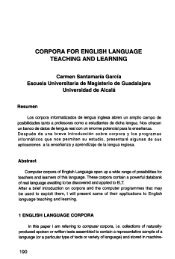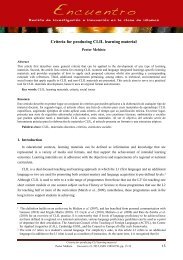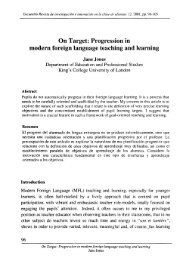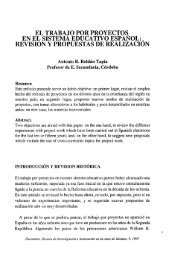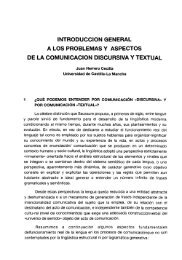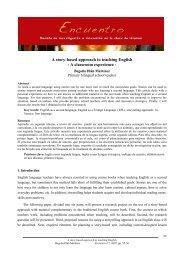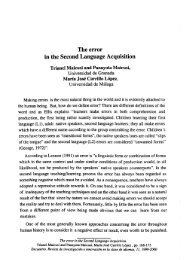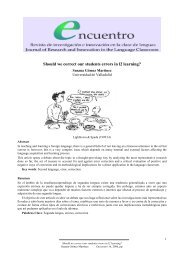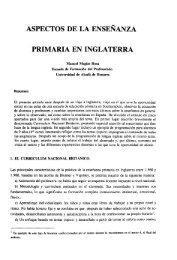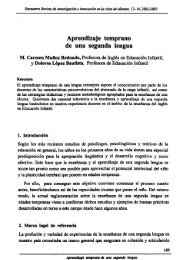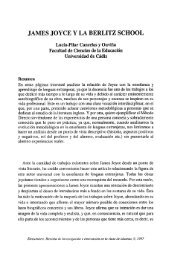European Framework for CLIL Teacher Education - CLIL-CD ...
European Framework for CLIL Teacher Education - CLIL-CD ...
European Framework for CLIL Teacher Education - CLIL-CD ...
Create successful ePaper yourself
Turn your PDF publications into a flip-book with our unique Google optimized e-Paper software.
Introduction<br />
Terminology<br />
Target<br />
Professional<br />
Competences<br />
Professional<br />
Development<br />
Modules<br />
<strong>European</strong><br />
<strong>Framework</strong><br />
<strong>for</strong> <strong>CLIL</strong><br />
<strong>Teacher</strong> <strong>Education</strong><br />
A framework <strong>for</strong> the professional<br />
development of <strong>CLIL</strong> teachers<br />
© David Marsh, Peeter Mehisto, Dieter Wolff, María Jesús Frigols Martín
Introduction<br />
This introductory section describes in general<br />
terms the <strong>European</strong> <strong>Framework</strong> <strong>for</strong> <strong>CLIL</strong> *<br />
<strong>Teacher</strong> <strong>Education</strong>. The importance of curriculum<br />
development in general, and more specifically<br />
in a <strong>CLIL</strong> context, is outlined. Challenges<br />
faced in establishing a common <strong>European</strong> <strong>CLIL</strong><br />
curriculum are discussed, as are the implications<br />
of these challenges <strong>for</strong> teacher training<br />
and professional development.<br />
* <strong>CLIL</strong> (Content and Language Integrated learning) is a dualfocused<br />
approach in which an additional language is used <strong>for</strong><br />
the learning and teaching of both content and language.<br />
2
1. Aim<br />
This <strong>European</strong> <strong>Framework</strong> <strong>for</strong> <strong>CLIL</strong> <strong>Teacher</strong> <strong>Education</strong><br />
aims to provide a set of principles and ideas <strong>for</strong> designing<br />
<strong>CLIL</strong> professional development curricula. Additionally,<br />
the <strong>Framework</strong> seeks to serve as a tool <strong>for</strong> reflection.<br />
It is proposed as a conceptual lens and model,<br />
not as a prescriptive template.<br />
2. Background<br />
This framework is the result of a <strong>CLIL</strong> curriculum development<br />
(<strong>CLIL</strong>-<strong>CD</strong>) project financed by the Empowering<br />
Language Professionals Programme of the <strong>European</strong><br />
Centre <strong>for</strong> Modern Languages. As <strong>CLIL</strong> programmes in<br />
the Council of Europe member states differ from country<br />
to country, in their organisation, content, intensity<br />
and choice of languages, this <strong>European</strong> <strong>Framework</strong> <strong>for</strong><br />
<strong>CLIL</strong> <strong>Teacher</strong> <strong>Education</strong> focuses on macro-level universal<br />
competences of <strong>CLIL</strong> educators. These have been<br />
identified through an examination of teacher education<br />
learning and curricular needs in <strong>CLIL</strong> contexts, and<br />
through a pan-<strong>European</strong> process of consultation.<br />
3. Curriculum development<br />
In the literature on curriculum design at least five different<br />
functions can be distinguished. These functions<br />
are also relevant <strong>for</strong> the development of a <strong>CLIL</strong> curriculum:<br />
(1) A curriculum defines an educational programme.<br />
Curricula list the contents of a programme which the<br />
learners are expected to acquire within a fixed period<br />
of time. Content is sequenced in the curriculum, i.e.<br />
built according to different parameters depending on<br />
desired learning outcomes and existing learner competences.<br />
3
(2) A curriculum is seen as a source of innovation by<br />
education authorities and/or higher education providers.<br />
New subjects or fields can be introduced; already<br />
existing content can be renewed. A new curriculum<br />
contains renewed learning aims, content and methodological<br />
guidelines.<br />
(3) A curriculum serves as a tool <strong>for</strong> planning and<br />
carrying out teaching-learning sequences. A detailed<br />
curriculum helps teachers, <strong>for</strong> example, to plan,<br />
prepare and carry out a sequence of learning. An educationally<br />
grounded curriculum is fundamental <strong>for</strong><br />
constructing modules and designing courses.<br />
(4) A curriculum is used as an instrument to evaluate<br />
teaching and learning. Curricula are issued by ministries<br />
of education or higher education authorities.<br />
These authorities need to evaluate and assess what<br />
is going on in a learning environment. Curricula also<br />
serve as terms of reference <strong>for</strong> the individual teacher<br />
to evaluate and improve his/her own teaching, and <strong>for</strong><br />
students and parents to evaluate student progress and<br />
to guide them in planning <strong>for</strong> improved learning.<br />
(5) A curriculum serves as a means <strong>for</strong> regulating,<br />
standardising and comparing teaching and learning<br />
at all levels. The curriculum is an important instrument<br />
<strong>for</strong> streamlining standards in a region, country,<br />
or collection of countries such as those of the Council<br />
of Europe.<br />
Curriculum development is also a means <strong>for</strong> building<br />
high quality <strong>CLIL</strong> programming. This <strong>European</strong> <strong>Framework</strong><br />
<strong>for</strong> <strong>CLIL</strong> <strong>Teacher</strong> <strong>Education</strong> is intended to serve<br />
as a point of reference <strong>for</strong> providers of teacher training<br />
across Europe. It aims to contribute to the development<br />
or enhancement of <strong>CLIL</strong> training that will support<br />
teachers in enriching their students’ learning experience.<br />
4
This <strong>European</strong> <strong>Framework</strong> <strong>for</strong> <strong>CLIL</strong> <strong>Teacher</strong> <strong>Education</strong><br />
provides curricular modules that can be adapted to<br />
meet the needs of educators working in diverse regional<br />
and national contexts. As well, this <strong>Framework</strong><br />
seeks to provide a conceptual lens and model <strong>for</strong> situating<br />
discussion about <strong>CLIL</strong>. The <strong>Framework</strong> can also<br />
offer a focus <strong>for</strong> additional research into <strong>CLIL</strong>. Such situated<br />
discussion and research can assist in the further<br />
legitimisation of this educational approach, facilitating<br />
its progression from that of an innovative ‘project’ to<br />
that of an even more solidly-rooted and potentially<br />
widespread modern educational practice.<br />
4. Challenges<br />
The overall major challenge, in the development and<br />
implementation of a teacher education curriculum in<br />
<strong>CLIL</strong>, is its integrative nature. This is the case at all levels<br />
of education – primary, secondary, tertiary, vocational<br />
and adult. <strong>CLIL</strong> seeks to teach two subjects in one –<br />
a content subject and a language. Content subjects,<br />
such as mathematics and an additional language, are<br />
usually taught separately.<br />
With the exception of primary teachers, other educators<br />
are often trained to teach just one subject be<br />
that a content subject or a language, as opposed to<br />
both. Even where teachers are trained in both a content<br />
subject and a language, training in the integration<br />
of language and content is not widespread. <strong>Teacher</strong>s<br />
undertaking <strong>CLIL</strong> will need to be prepared to develop<br />
multiple types of expertise: among others, in the content<br />
subject; in a language; in best practice in teaching<br />
and learning; in the integration of the previous three;<br />
and, in the integration of <strong>CLIL</strong> within an educational<br />
institution.<br />
The <strong>European</strong> <strong>Framework</strong> <strong>for</strong> <strong>CLIL</strong> <strong>Teacher</strong> <strong>Education</strong><br />
5
cannot focus on all the content subjects which are<br />
taught in school systems, or on the languages which<br />
might be used as a medium of instruction. The <strong>Framework</strong><br />
as such is neutral with respect to these aspects,<br />
and it does not cater <strong>for</strong> specific competence development<br />
in any one content subject or language. Rather,<br />
it is focused on the competences necessary to teach<br />
content subjects and an additional language in an integrated<br />
manner.<br />
6
Terminology<br />
The definitions presented here seek to situate<br />
key terms used in the <strong>Framework</strong> within a defined<br />
scope of meaning. Where pan-<strong>European</strong><br />
bodies have already defined terms, those definitions<br />
are given preference.<br />
8
Attitude<br />
(Preconceived) ideas or beliefs which a person has towards<br />
other persons, situations, members of society,<br />
ideologies, events, etc. Sarnoff (1970) defines attitude<br />
as ‘a disposition to react favourably or unfavourably to<br />
a class of objects.’ Attitude becomes visible through behaviours<br />
and an outward expression of beliefs or feelings<br />
and can either support or impede learning. Critical<br />
reflection and dialogue about the socially constructed<br />
nature of attitude can help individuals to better understand<br />
and manage their own attitudes and learning, as<br />
can meta-affective and meta-cognitive awareness.<br />
Assessment<br />
A process of collecting and interpreting evidence <strong>for</strong><br />
some purpose. In education, assessment is intended<br />
to be a tool that supports learning and helps measure<br />
progress being made toward achieving planned learner<br />
outcomes. The term assessment is sometimes used<br />
interchangeably with the term ‘evaluation’. Assessment<br />
more often relates to individual students’ achievements,<br />
whereas ‘evaluation’ deals with systems, materials,<br />
procedures and their values.<br />
A distinction is made between <strong>for</strong>mative and summative<br />
assessment. In <strong>for</strong>mative assessment the student’s<br />
learning (attitudes, skills, habits and knowledge)<br />
is analysed with the student over longer stretches of<br />
time and used to improve learning and teaching. Summative<br />
assessment is based on discrete-point testing<br />
of a student’s learning, often at the end of a unit or year<br />
of study.<br />
Summative assessment procedures are often linked to<br />
external tests validated by statistical measures and are<br />
often used to make very important decisions about stu-<br />
9
dents (e.g., pass/fail) and/or teachers (e.g., adequate/<br />
inadequate teaching per<strong>for</strong>mance).<br />
Whereas <strong>for</strong>mative assessment helps build learner<br />
and teacher autonomy including the capacity to better<br />
manage learning, so-called ´high-stakes´ summative<br />
assessment is considered by many researchers to<br />
lead to significant negative consequences including<br />
reduced learning outcomes.<br />
Change models<br />
Change models are frameworks that support organisations<br />
in managing change such as the introduction of<br />
innovation in education.<br />
Kotter (1995, 2002) details eight steps that characterise<br />
change: establishing a sense of urgency; creating a<br />
guiding coalition; developing strategy and vision; communicating<br />
the change vision; empowering broadbased<br />
action; generating short-term wins; consolidating<br />
gains and producing more change; and anchoring<br />
new approaches in culture.<br />
Fullan (2001) proposes: maintaining a focus on moral<br />
purpose; understanding change; increasing coherence<br />
among various aspects of a planned change; relationship-building;<br />
knowledge creation and sharing;<br />
and building commitment among an organisation’s<br />
internal and external members (stakeholders).<br />
Bennet and Bennet (2008) suggest professionals undertake<br />
the changes they see fit. Individuals are encouraged<br />
to manage their own learning, and to plan<br />
change by taking into account the following factors:<br />
awareness, understanding, personal feelings and beliefs,<br />
ownership, empowerment, and impact.<br />
Awareness of change models can help educators manage<br />
change more effectively. Moreover, awareness of<br />
10
and building skills in using these models can help both<br />
educators and students develop autonomy and agency.<br />
<strong>CLIL</strong> (Content and Language<br />
Integrated Learning)<br />
<strong>CLIL</strong> is a dual-focused educational approach in which<br />
an additional language is used <strong>for</strong> the learning and<br />
teaching of content and language with the objective of<br />
promoting both content and language mastery to predefined<br />
levels (Maljers, Marsh, Wolff, Genesee, Frigols-<br />
Martín, Mehisto, 2010).<br />
Competence<br />
The demonstrated ability to use knowledge, skills and<br />
personal, social and/or methodological abilities, in<br />
work or study situations and in professional and personal<br />
development. In the context of the <strong>European</strong><br />
Qualifications <strong>Framework</strong>, competence is described in<br />
terms of responsibility and autonomy (<strong>European</strong> Commission,<br />
2008).<br />
(<strong>European</strong> key) competences<br />
<strong>for</strong> lifelong learning<br />
These eight interdependent key competences describe<br />
the essential knowledge, skills and attitudes central to<br />
lifelong learning. They all emphasise critical thinking,<br />
creativity, initiative, problem solving, risk assessment,<br />
decision taking, and constructive management of feelings.<br />
The eight key competences are: communication<br />
in the mother tongue; communication in <strong>for</strong>eign languages;<br />
mathematical competence and basic competences<br />
in science and technology; digital competence;<br />
learning to learn; social and civic competences; sense<br />
11
of initiative and entrepreneurship; cultural awareness<br />
and expression (<strong>European</strong> Parliament and the Council,<br />
2006).<br />
Evaluation<br />
The term is often used ‘to denote the process of collecting<br />
evidence about programmes, systems, procedures<br />
and processes‘ and the interpretation of that evidence<br />
with respect to stated or desired objectives (Harlen,<br />
2007). For example, evaluation provides in<strong>for</strong>mation<br />
about the quality of a curriculum, a study programme<br />
or teaching. Like assessment (cf.), evaluation makes use<br />
of <strong>for</strong>mative and summative approaches; but instead<br />
of assessing the student’s individual ef<strong>for</strong>ts and results<br />
these are analysed with respect to wider ‘system-based’<br />
issues such as a whole programme, significant parts of<br />
the programme or key features such as how teachers<br />
teach and how groups of students learn.<br />
Grounded professional<br />
confidence<br />
Knowing when one’s thinking and skills are sound<br />
enough to make one’s own decisions, and taking action<br />
thereon when appropriate, whilst maintaining a<br />
high level of professional standards and advancing<br />
one’s own learning (Mehisto, 2010).<br />
Knowledge<br />
The outcome of the assimilation of in<strong>for</strong>mation<br />
through learning. Knowledge is the body<br />
of facts, principles, theories and practices that is<br />
related to a field of work or study. In the context of the<br />
<strong>European</strong> Qualifications <strong>Framework</strong>, knowledge is described<br />
as theoretical and/or factual.<br />
12
Learner autonomy<br />
‘The ability to take charge of one’s own learning’ (Holec,<br />
1981). Expanding on this definition, David Little (1991)<br />
states that learner autonomy includes a ‘capacity <strong>for</strong><br />
detachment, critical reflection, decision-making and<br />
independent action’.<br />
Learning outcomes<br />
An outcome describes the enduring knowledge, skills,<br />
abilities and attitudes which allow a student to exercise<br />
and apply learning in his or her personal and professional<br />
life. More simply expressed, it is what a student<br />
knows and can do as a result of what he or she has<br />
learnt. Outcomes are often defined in terms of competences.<br />
Professional learning<br />
communities<br />
‘A professional learning community is an inclusive<br />
group of people, motivated by a shared learning vision,<br />
who support and work with each other, finding<br />
ways, inside and outside their immediate community,<br />
to enquire on their practice and together learn new<br />
and better approaches that will enhance all pupils’<br />
learning’ (Stoll et al., 2006).<br />
Professional learning communities tend to:<br />
• have shared values and visions<br />
• assume collective responsibility <strong>for</strong> student learning<br />
• foster reflective professional inquiry<br />
• facilitate collaboration, which includes open and<br />
frank debate<br />
• promote group, as well as individual learning (Bolam<br />
et al., 2005).<br />
13
Skills<br />
The ability to apply knowledge and use know-how to<br />
complete tasks and solve problems. In the context of<br />
the <strong>European</strong> Qualifications <strong>Framework</strong> (<strong>European</strong> Parliament<br />
and Council, 2008), skills are described as cognitive<br />
(involving the use of logical, intuitive and creative<br />
thinking) or practical (involving manual dexterity and<br />
the use of methods, materials, tools and instruments).<br />
14
Target Professional<br />
Competences<br />
These are the target professional competences<br />
that the <strong>CLIL</strong> teacher is expected to acquire<br />
or further develop during the training programme.<br />
16
1. PERSONAL REFLECTION<br />
Commitment to one’s own cognitive, social and affective<br />
development is fundamental to being able to support<br />
the cognitive, social and affective development of<br />
students.<br />
<strong>CLIL</strong> teachers are able:<br />
a) to explore, and to articulate their own understanding<br />
of, and attitudes towards, generally accepted<br />
principles of teaching and learning (Professional<br />
Development Component 3). *<br />
b) to explore and to articulate their understanding of,<br />
and attitudes towards content and language (L1,<br />
L2, L3) learning, as well as learning skills development<br />
in <strong>CLIL</strong> (PDC 3)<br />
c) to define their own pedagogical and content (subject<br />
field) competences, and related developmental<br />
needs (PDC 3)<br />
d) to define their level of language competence according<br />
to the Common <strong>European</strong> <strong>Framework</strong> of<br />
Reference (CEFR), and to articulate related developmental<br />
needs (PDC 8)<br />
e) to explore and to articulate ways of working with<br />
learners to jointly identify teacher and student socio-cultural,<br />
personal and vocational learning needs<br />
(PDC 4, 5, 6, 7)<br />
f ) to explore and to articulate the necessity to cooperate<br />
with colleagues and other key <strong>CLIL</strong> stakeholders,<br />
and describe mechanisms <strong>for</strong> cooperation (PDC<br />
4, 8, 11)<br />
g) to work according to the principles of grounded<br />
professional confidence (PDC 6)<br />
h) to develop and to update their own professional<br />
* NB: The numbering of the twelve PDC components is consecutive<br />
throughout the three Professional Development<br />
Modules.<br />
17
development plan (PDC 2)<br />
i) to explore and to manage the multiple roles and<br />
identities of a <strong>CLIL</strong> teacher (PDC 6)<br />
j) to explore and to manage the impact of one’s own<br />
attitudes and behaviour on the learning process<br />
(PDC 6)<br />
2. <strong>CLIL</strong> FUNDAMENTALS<br />
An understanding of the core features of <strong>CLIL</strong>, and how<br />
these link with best practices in education, is central to<br />
the <strong>CLIL</strong> approach, as are building inclusive and constructive<br />
relationships with students and other stakeholders.<br />
<strong>CLIL</strong> teachers are able:<br />
a) to describe core features of the <strong>CLIL</strong> approach (definition,<br />
models, planned outcomes, methodology,<br />
driving principles) (PDC 1, 6)<br />
b) to describe common misconceptions vis-à-vis <strong>CLIL</strong><br />
(PDC 1, 2, 3)<br />
c) to contextualise <strong>CLIL</strong> with respect to the school, regional<br />
and/or national curriculum (PDC 1, 4)<br />
d) to articulate and discuss <strong>CLIL</strong> with school’s internal<br />
and external stakeholders (PDC 4, PDC 5)<br />
e) to describe strategies <strong>for</strong> integrating <strong>CLIL</strong> and existing<br />
school ethos (PDC 4)<br />
3. CONTENT AND LANGUAGE<br />
AWARENESS<br />
In <strong>CLIL</strong>, successful content learning is particularly dependent<br />
on language: enhanced language learning<br />
is dependent on content learning. Research-based<br />
knowledge of the interdependence of language (L1,<br />
L2, L3) and cognitive development facilitates both<br />
content and language learning.<br />
18
<strong>CLIL</strong> teachers are able:<br />
a) to identify the appropriate content to be taught<br />
and obstacles to content learning (PDC 3, 5, 6)<br />
b) to view content through different cultural perspectives<br />
(PDC 5, 7)<br />
c) to deploy strategies to support language learning<br />
in content classes (PDC 3, 4, 5, 6)<br />
d) to create opportunities <strong>for</strong> rein<strong>for</strong>cing content<br />
learning in language classes (PDC 3, 4, 6)<br />
e) to apply strategies <strong>for</strong> fostering critical thinking by<br />
students about content and language (PDF 3, 4, 6)<br />
f ) to apply strategies <strong>for</strong> fostering in students the habit<br />
of linking new learning with their personal experience<br />
(e.g., language, content subjects, personal<br />
experience and the out-of-school world) (PDC 3, 9,<br />
11)<br />
g) to promote learner awareness of language and the<br />
language learning process (PDC 3, 6)<br />
h) to describe how the first language can support additional<br />
language learning (PDC 3)<br />
i) to model strategies <strong>for</strong> making the transition from<br />
monolingual to bi/plurilingual teaching and learning<br />
(PDC 1, 2, 3)<br />
j) to devise and implement strategies that take into<br />
account key concepts such as (critical) discourse,<br />
domains and registers, Basic Interpersonal Communication<br />
Skills, Cognitive Academic Language<br />
Proficiency in order to promote language and content<br />
learning, as well as learning skills development<br />
(PDC 3, 6)<br />
k) to describe the implication of age <strong>for</strong> language<br />
learning and use (PDC 3, 5, 6)<br />
l) to link language awareness issues to content learning<br />
and cognition (PDC 3, 5, 6)<br />
m) to scaffold language learning during content classes<br />
(PDC 5, 6)<br />
19
n) to propose instructional strategies that take into account<br />
social constructivist theory, including exploratory<br />
and other <strong>for</strong>ms of discourse that promote<br />
dialogic teaching and learning (PDC 3)<br />
o) to draw on knowledge and theories from language<br />
learning fields such as SLA to propose instructional<br />
and learning strategies (PDC 3)<br />
4. METHODOLOGY AND<br />
ASSESSMENT<br />
In <strong>CLIL</strong> aspects of good pedagogy are applied in a new<br />
manner. Due to the challenges of learning through an<br />
additional language, many aspects of good pedagogy<br />
require enhanced and detailed scaffolding. A wide<br />
range of knowledge and skills relating to methodology<br />
and assessment are integrated in order to create<br />
meaningful and supportive learning experiences <strong>for</strong><br />
students.<br />
Building learner capacity<br />
<strong>CLIL</strong> teachers are able:<br />
a) to support learners in building their capacity:<br />
• to self-motivate (PDC 1)<br />
• to self-assess so that they can become more<br />
reflective and autonomous (PDC 6, 7, 8, 10)<br />
• to constructively give, receive and use teacher<br />
and peer assessment/feedback (PDC 6,10)<br />
• to cooperate with the teacher so as to reflect on,<br />
and improve learning (PDC 6, 7)<br />
• to identify and analyse preferred learning styles,<br />
and to expand and effectively use these and others<br />
(PDC 3, 7)<br />
20
Co-operating with colleagues<br />
<strong>CLIL</strong> teachers are able:<br />
a) to nurture cooperation with colleagues and have a<br />
repertoire of cooperation strategies and skills (PDC<br />
4, 5)<br />
b) to cooperate with colleagues so as to reflect on and<br />
improve learning (PDC 6, 7)<br />
Deploying strategies<br />
<strong>CLIL</strong> teachers are able to:<br />
a) deploy strategies:<br />
• <strong>for</strong> the co-construction of knowledge with learners<br />
and <strong>for</strong> cooperative learning (PDC, 3, 5, 6, 7)<br />
• <strong>for</strong> fostering critical thinking (PDC 3, 6)<br />
b) support continuous language growth through a<br />
repertoire of didactic strategies (e.g., Zone of Proximal<br />
Development, error awareness and correction,<br />
first language transfer and interference, translanguaging,<br />
anti-plateauing strategies and modelling)<br />
(PDC 3, 6)<br />
c) deploy blended learning approaches in the <strong>CLIL</strong><br />
classroom (PDC 3, 6)<br />
Building direction and focus<br />
<strong>CLIL</strong> teachers are able:<br />
a) to work with learners to jointly identify learners’<br />
needs in <strong>CLIL</strong> (PDC 3, 5, 6, 7)<br />
b) to design <strong>CLIL</strong> modules and lessons within the context<br />
of a given curriculum (PDC 4, 5, 6)<br />
c) to identify key concepts of content subjects and<br />
make them accessible to learners by modifying<br />
teaching to take into account students’ diverse language<br />
competences and needs (PDC 6, 7)<br />
21
d) to set outcomes together with learners regarding<br />
language, content and learning skills (PDC 5, 6)<br />
e) to maintain a triple focus that supports content,<br />
language and learning skills development (PDC 6)<br />
f ) to build on prior language and content knowledge,<br />
skills, attitudes and experiences of learners (PDC 6,<br />
7)<br />
g) to take guidance from the <strong>European</strong> Key Competences<br />
<strong>for</strong> Lifelong Learning (PDC 10)<br />
Building safe and meaningful<br />
learning experiences<br />
<strong>CLIL</strong> teachers are able:<br />
a) to support students in managing the affective side<br />
of learning through an additional language (PDC<br />
7)<br />
b) to create authentic and meaningful learning environments<br />
and experiences <strong>for</strong> students (e.g., group<br />
work, peer teaching and work placement) (PDC 3, 5,<br />
7)<br />
c) to create supportive structures to foster contact and<br />
communication with other speakers of the <strong>CLIL</strong> language<br />
(PDC 6, 11)<br />
22
Assessing<br />
<strong>CLIL</strong> teachers are able:<br />
a) to articulate <strong>CLIL</strong>-specific assessment needs and<br />
goals, and to develop and implement related assessment<br />
tools (PDC 8, 9, 10)<br />
b) to identify what learners already know (PDC 5, 10)<br />
c) to guide learner reflection on previously agreed<br />
upon content, language and learning skills, goals/<br />
outcomes, achievements (PDC 2, 10)<br />
d) to guide learners in using portfolio-based approaches<br />
(including the <strong>European</strong> Language Portfolio)<br />
as tools <strong>for</strong> fostering learning, teaching and<br />
assessment (PDC 10)<br />
e) to use <strong>for</strong>mative and summative assessment strategies<br />
to support content, language and learning<br />
skills development (PDC 5, 6, 8, 10)<br />
f ) to use benchmarking in supporting progress in<br />
learning (PDC 6, 8, 10)<br />
g) to introduce the concepts of self-assessment and<br />
peer-assessment to support learners in taking<br />
greater responsibility <strong>for</strong> their learning (PDC 6, 8,<br />
10)<br />
h) to detail the pitfalls of assessment and propose<br />
ways of circumnavigating these (PDC 8, 10)<br />
23
5. RESEARCH AND<br />
EVALUATION<br />
A dynamic <strong>CLIL</strong> teacher is a learner who follows a personal<br />
path of enquiry, reflection, and evaluation. This<br />
provides an active model <strong>for</strong> students to develop the<br />
ways and means of learning through their own research<br />
and evaluation. These are powerful tools <strong>for</strong> improving<br />
teaching and learning.<br />
<strong>CLIL</strong> teachers are able:<br />
a) to discuss, in a knowledgeable manner, classroom<br />
and learner research methodology (e.g., action research)<br />
(PDC 2, 9)<br />
b) to conduct action research in collaboration with<br />
colleagues and other stakeholders, including students<br />
(PDC 2, 9)<br />
c) to articulate key research findings relevant to <strong>CLIL</strong><br />
and learning in general (e.g., second language acquisition<br />
research, psychology of knowledge and<br />
evidence-based teaching) (PDC 2, 9)<br />
d) to critically analyse research articles on <strong>CLIL</strong> (PDC<br />
9)<br />
e) to use benchmarking (regional, national or international)<br />
when interpreting and planning research<br />
and evaluation (PDC 2, 10)<br />
f ) to describe strategies and instruments <strong>for</strong> self, peer<br />
and student evaluation of their teaching practices<br />
(PDC 2, 9, 10)<br />
g) to use self, peer and student evaluation to improve<br />
their own practice and student learning (PDC 2, 9,<br />
10)<br />
h) to critically interpret research and evaluation results<br />
(PDC 2, 9, 10)<br />
24
6. LEARNING RESOURCES<br />
AND ENVIRONMENTS<br />
<strong>CLIL</strong> requires <strong>CLIL</strong>-specific learning resources, and<br />
enriched learning environments. These are highly integrative,<br />
multilayered and cognitively demanding,<br />
yet are balanced by enhanced scaffolding and other<br />
support systems. These help students build a sense of<br />
security in experimenting with language, content, and<br />
the management of their own learning.<br />
<strong>CLIL</strong> teachers are able:<br />
a) to maintain a triple focus on content, language and<br />
learning skills (PDC 4, 5, 8)<br />
b) to design and use cognitively and linguistically appropriate<br />
learning materials (PDC 4, 5, 8)<br />
c) to create criteria <strong>for</strong> developing <strong>CLIL</strong> resources (including<br />
multimedia) that embed the core features<br />
of <strong>CLIL</strong> (PDC 8)<br />
d) to describe criteria and strategies <strong>for</strong> using nonclassroom<br />
and non-school learning environments<br />
(PDC 5, 11)<br />
e) to assess learning resources and environments and<br />
to identify potential difficulties and solutions to<br />
overcome these (PDC 4, 8, 11)<br />
f ) to articulate techniques <strong>for</strong> developing cooperative<br />
networks aimed at choosing, creating, adapting<br />
and accessing materials or developing learning resources<br />
and accessing learning environments (PDC<br />
8,11)<br />
g) to help students build cross-curricular links (PDC 4,<br />
8, 11)<br />
25
7. CLASSROOM<br />
MANAGEMENT<br />
<strong>CLIL</strong> classroom management aims to facilitate the integrated<br />
learning of content, language and learning<br />
skills. It requires specific knowledge about classroom<br />
dynamics and management techniques and about<br />
how these affect learning in <strong>CLIL</strong>. Classroom management<br />
also centres on helping students to access intrinsic<br />
motivations <strong>for</strong> learning. This is partly done by<br />
enabling them to share responsibility <strong>for</strong> classroom<br />
management and the co-construction of learning.<br />
<strong>CLIL</strong> teachers are able:<br />
a) to use diverse classroom set-ups to promote student<br />
communication, cooperative learning and<br />
leadership (PDC 6, 7, 8)<br />
b) to use appropriate language <strong>for</strong> classroom interaction<br />
in order to manage classroom proceedings<br />
(PDC 5, 6)<br />
c) to recognise and make use of opportunities provided<br />
by learners’ linguistic and cultural diversity (PDC<br />
6, 7)<br />
d) to cater <strong>for</strong> learners with a wide range of needs (e.g.,<br />
special and specific needs, socio-economic and socio-cultural<br />
background, and gender) (PDC 5, 7)<br />
e) to co-create with students a non-threatening environment<br />
that is driven by learning and the active<br />
participation of all students (PDC 5, 7)<br />
26
8. <strong>CLIL</strong> MANAGEMENT<br />
Developing quality <strong>CLIL</strong> is a complex undertaking involving<br />
many stakeholders including students, parents,<br />
<strong>CLIL</strong> teachers, non-<strong>CLIL</strong> teachers and administrators.<br />
This calls on stakeholders to build common<br />
knowledge about programme management and an<br />
understanding of each other’s role in supporting its<br />
development.<br />
<strong>CLIL</strong> teachers are able:<br />
a) to work within change models (PDC 1, 4, 5)<br />
b) to apply the principles of professional learning communities,<br />
models and strategies (PDC 4)<br />
c) to work with internal and external stakeholders<br />
(PDC 1, 4)<br />
d) to apply the principles of professional self-management<br />
(PDC 4)<br />
e) to represent the interests of <strong>CLIL</strong> in public relations<br />
(PDC 4)<br />
f ) to describe ethical issues pertaining to <strong>CLIL</strong> including<br />
gender and other inclusion issues (PDC 4, 7)<br />
27
Professional Development<br />
Modules<br />
These descriptions summarise the contents of<br />
the modules in the <strong>European</strong> <strong>Framework</strong> <strong>for</strong><br />
<strong>CLIL</strong> <strong>Teacher</strong> <strong>Education</strong>. Each module consists<br />
of non-sequential components and their description.<br />
These descriptions are based on, and<br />
linked to, the Target Professional Competences<br />
defined in the previous section of this publication.<br />
30
Module 1: Approaching <strong>CLIL</strong><br />
(four components)<br />
1. Situating <strong>CLIL</strong><br />
• Competences <strong>for</strong> the in<strong>for</strong>mation age<br />
• Bi-, multi- and plurilingualism: overview<br />
• Bilingual education: past and present; assumptions<br />
and facts<br />
• <strong>CLIL</strong> contexts, models and variants<br />
• <strong>CLIL</strong> objectives<br />
• <strong>CLIL</strong> aims and objectives within a regional/national<br />
and institutional infrastructure<br />
• Autonomy, authenticity, agency<br />
• Professionalism and personal profile<br />
(Target Professional Competence standards: 1, 2, 4, 8)<br />
2. Adopting action research<br />
• Grounded theory and cyclic learning<br />
• Literature review and application<br />
• Action research in the school context: objectives,<br />
tools, design<br />
• <strong>CLIL</strong> teaching and learning processes: data analysis<br />
• Evidence-based planning and action<br />
(Competence standards: 1, 5)<br />
3. Examining good pedagogy and <strong>CLIL</strong><br />
• Awareness-raising of personal established teaching<br />
practice<br />
• Socio-constructivist theories and content/language<br />
teaching<br />
• Autonomy, authenticity and agency<br />
• Critical and creative thinking<br />
• Language learning/acquisition theories<br />
31
• Language awareness and knowledge about<br />
language learning<br />
• Content awareness and knowledge about content<br />
learning<br />
• Content-subject specific awareness<br />
• Awareness of language user profiles, identities,<br />
and affective factors<br />
• Integration of personal established practice and<br />
new approaches<br />
• Learning styles<br />
• Learning skills<br />
(Competence standards: 1, 3, 4)<br />
4. Focusing on <strong>CLIL</strong> in the school context<br />
• Legislative and policy frameworks<br />
• School change management<br />
• Self-management and professional capacitybuilding<br />
• Curriculum integration and team dynamics<br />
• Student inclusion, exclusion and access<br />
• Tools <strong>for</strong> planning and co-operation<br />
• School ethos (i.e. beliefs, attitudes, work processes)<br />
(Competence standards: 7, 8)<br />
32
Module 2: Implementing <strong>CLIL</strong><br />
(four components)<br />
5. Designing <strong>CLIL</strong> classroom curricula<br />
• Theoretical constructs of curriculum design<br />
• <strong>CLIL</strong> course construction<br />
-- Objectives/targets of content learning<br />
-- Course syllabus (including learner-teacher<br />
negotiation)<br />
-- Cross-curricular linkages<br />
-- Planned learning outcomes (content, language,<br />
learning skills and cognition)<br />
-- Intercultural aspects of course design<br />
-- Design of teaching and learning units/modules<br />
• <strong>CLIL</strong> course scheduling<br />
-- Embedding <strong>CLIL</strong> in the school curriculum<br />
-- Time allocation<br />
-- <strong>Teacher</strong> interaction and cooperation<br />
(Competence standards: 4, 7, 8)<br />
6. Anchoring <strong>CLIL</strong> in the classroom<br />
• General principles of educational practice applied<br />
to <strong>CLIL</strong><br />
• <strong>CLIL</strong> core features<br />
-- Multiple focus<br />
-- Safe and enriching learning environments<br />
-- Authenticity<br />
-- Active learning<br />
-- Scaffolding<br />
-- Cooperation<br />
33
• <strong>CLIL</strong> driving principles<br />
-- Cognition<br />
-- Community<br />
-- Content<br />
-- Communication<br />
• Interdisciplinarity and multimodality<br />
-- Constructivist and cognitive psychological<br />
approaches<br />
-- Lessons from brain sciences<br />
-- Integration of subjects<br />
-- Blended modalities<br />
• Learner autonomy and agency<br />
-- Deciding on and managing one’s own learning<br />
-- Planning targets<br />
-- Benchmarking and self-assessment<br />
-- Intrinsic motivation<br />
(Competence standards: 4, 5, 8)<br />
7. Interweaving psychological and<br />
pedagogical aspects in the <strong>CLIL</strong><br />
classroom<br />
• Affective dimensions of learning<br />
• Impact of e-learning<br />
• Vehicular language threshold levels<br />
• Reduced personality syndrome<br />
• Expansion of personal learning styles repertoire<br />
• Attitude awareness<br />
• Group dynamics<br />
• Special and specific educational needs<br />
• Intercultural and plurilingual dynamics<br />
• Multicultural and multilingual issues<br />
• Student learning profiles and identities<br />
(Competence standards: 4, 7)<br />
34
8. Accessing and adapting <strong>CLIL</strong> learning<br />
resources and environments<br />
• Criteria <strong>for</strong> and evaluation of learning materials<br />
• Common <strong>European</strong> <strong>Framework</strong> of Reference <strong>for</strong><br />
Languages<br />
• Learning materials and environments which<br />
support peer co-operation, authenticity and<br />
autonomy<br />
• <strong>Teacher</strong> co-operation through networking<br />
(Competence standards: 4, 6)<br />
9. Becoming an evidence-based practitioner<br />
• Evidence-based analysis, planning and decision<br />
making<br />
• Research questions, design and testing<br />
• Data analysis and reporting<br />
• Application of evidence-based learning<br />
(Competence standards: 5)<br />
Module 3: Consolidating <strong>CLIL</strong><br />
(three components)<br />
10. Assessing <strong>for</strong> learning<br />
• Principles and objectives of assessment and<br />
evaluation as a basis <strong>for</strong> improvement<br />
• Summative and <strong>for</strong>mative evaluation: principles,<br />
modes and tools (Common <strong>European</strong> <strong>Framework</strong><br />
of Reference <strong>for</strong> Languages, <strong>European</strong> Language<br />
Portfolio)<br />
• Risks and gate-keeping<br />
• Certification<br />
(Competence standards: 4, 5)<br />
35
11. Networking locally, nationally and<br />
internationally<br />
• Network theory, systems, tools and resources<br />
• Professional support and synergy<br />
• Professional learning communities<br />
• Learning environments development<br />
• Knowledge management<br />
• Linkages to local, national and international<br />
communities<br />
(Competence standards: 4, 8)<br />
12. Practising <strong>CLIL</strong><br />
• Criteria and frameworks <strong>for</strong> practice-teaching<br />
• Planning tools<br />
• Analysing and addressing individual needs<br />
• Potential problems: diagnosis and solutions<br />
• The mentor-practice teacher relationship<br />
• Self-management<br />
• Evaluation, assessment and analysis<br />
• Professional development plan<br />
(Competence standards: 1, 2, 3, 4, 5, 6, 7, 8)<br />
36
Acknowledgements<br />
Numerous people and institutions have contributed to the development<br />
of this <strong>Framework</strong>. In particular, we would like to thank the <strong>European</strong><br />
Centre <strong>for</strong> Modern Languages <strong>for</strong> their advice and support. Valuable<br />
input was received from representatives of Council of Europe member<br />
states, and other experts attending a two-day workshop in 2009 (see<br />
http://clil-cd.ecml.at <strong>for</strong> participants’ list). Additionally, the following individuals<br />
have made an important contribution to the development of<br />
this document: Hugo Baetens Beardsmore, Patricia Bertaux, Carmel Mary<br />
Coonan, Fred Genesee and Gisella Langé.
The <strong>European</strong> <strong>Framework</strong> <strong>for</strong> <strong>CLIL</strong> <strong>Teacher</strong> <strong>Education</strong><br />
The <strong>European</strong> <strong>Framework</strong> <strong>for</strong> <strong>CLIL</strong> <strong>Teacher</strong> <strong>Education</strong> (EFCT) is a tool <strong>for</strong> guiding the design<br />
of curricula <strong>for</strong> <strong>CLIL</strong> teacher professional development. The EFCT is proposed as a conceptual<br />
lens and model.<br />
The <strong>European</strong> Centre <strong>for</strong> Modern Languages (ECML)<br />
Promoting excellence in language education<br />
Established in 1995 in Graz, Austria, as a Council of Europe institution, the ECML focuses on<br />
bridging the gap between language policy theory and classroom learning practice. This<br />
unique intergovernmental centre offers concrete approaches to issues and challenges facing<br />
Europe’s multicultural societies in a period of unparalleled change and mobility.<br />
The ECML, guided by its 34 member states * , is committed to the Council of Europe’s policy<br />
of fostering linguistic and cultural diversity as a means of promoting intercultural dialogue,<br />
democratic citizenship and human rights.<br />
The present publications series represents the results of international projects organised within<br />
the Centre’s Empowering language professionals programme (2008-2011). Through this<br />
programme the ECML has sought to increase awareness of and confidence in the capacities<br />
of professionals in language education and to enable members of the profession to be more<br />
actively involved in defining and delivering higher standards of language education.<br />
The publications within the present series illustrate the dedication of the coordinating teams<br />
and of all those who participated within the projects and their commitment to furthering innovation<br />
and good practice in language education.<br />
For in<strong>for</strong>mation on the <strong>European</strong> Centre <strong>for</strong> Modern Languages and its publications visit the<br />
ECML website: http://www.ecml.at<br />
The Council of Europe has 47 member states, covering virtually the entire continent of Europe.<br />
It seeks to develop common democratic and legal principles based on the <strong>European</strong> Convention<br />
on Human Rights and other reference texts on the protection of individuals. Ever since<br />
it was founded in 1949, in the aftermath of the second world war, the Council of Europe has<br />
symbolised reconciliation.<br />
design by: www.tm.ee<br />
* Albania, Andorra, Armenia, Austria, Bosnia and Herzegovina, Bulgaria, Croatia, Cyprus, Czech Republic, Estonia,<br />
Finland, France, Germany, Greece, Hungary, Iceland, Ireland, Latvia, Liechtenstein, Lithuania, Luxembourg, Malta,<br />
Montenegro, Netherlands, Norway, Poland, Romania, Slovak Republic, Slovenia, Spain, Sweden, Switzerland, “the<br />
Former Yugoslav Republic of Macedonia”, United Kingdom


